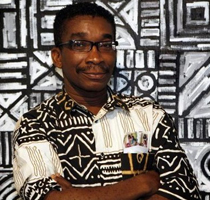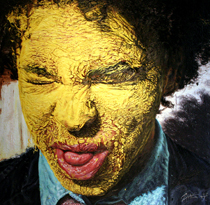I would not mind at all if Okwui Enwezor were to define the kind of contemporary African art he is propagating as “Contemporary African Diaspora Art,†“Contemporary African Art in the Diaspora,†“Contemporary African Art Abroad†or “Contemporary African Art in the West (USA or Europe).†But to define contemporary African art which dispenses completely of the African continent and its colonial and post-colonial history, situating it wholly in the West, in the Africa Diaspora, is a distortion of history, an aberration of the truth and a travesty of justice to the African – an affront to his dignity, self-esteem and ingenuity. Enwezor’s enunciation of “Africa is nowhere, Africa is everywhere†will not hold water and should be challenged to the hilt. How could defining contemporary African art preclude the geographical boundary and terrain of the mother African continent as a vital arena for the production of art? The land mass of the African continent is totally ostracized in Enwezor’s bizarre definition of contemporary African art. I find this very puzzling. And why should Okwui Enwezor now be attempting to define and redefine what Contemporary African art is when it has been so well defined in the past, and we are all clear in our minds about what it is?
Because earlier definitions of contemporary African art had always recognized the presence of the African Diaspora as an essential component of the African continent, Nicole Guez’s Guide-Contemporary African Art, Editions 1992-94, 1996-1998, feature as well a listing of African artists living and working abroad. Book surveys on contemporary African art, like Kojo Fosu’s Twentieth Century Art of Africa and Jean Kennedy’s New Currents, Ancient Rivers: Contemporary African Artists in a Generation of Change  had always covered African Artists on the continent as well as in the Diaspora, with the higher distribution being African artists in Africa. However, Enwezor’s theoretical definition of contemporary African art, which turns its back to all that has gone on artistically on the African continent, and centers the contemporaneity of African art practice and thought in the Western metropolis, buttressed by the philosophies of Paul Gilroy and V.Y. Mudimbe is, indeed, very disturbing. It is outrageous and bogus, to say the least, and should be rejected outright!
Yes, the African Diaspora, no doubt, is important. It has contributed in many ways to the motherland, particularly in the remittances of often scarce foreign-exchange back home to shore up ailing economies. It is, however, only an adjunct to the motherland. The African Diaspora can never, ever supplant or subjugate the motherland. If, indeed, the real Africa, as postulated by Okwui Enwezor and his cohorts of curators and writers, is the African Diaspora, then we might as well sell the whole African continent, and ensure all Africans go and live in the West. There will be no need to continue our humble strife at nation building for generations to come, nor continue our implacable determination to build a continent with good governance, good democratic governments, vibrant parliaments, a free press, an energetic private sector, a market economy, rule of law, art galleries, museums and all the modern-day amenities and infrastructure for our comfortable living, just as you find in the West.
I do not hold anything against my colleagues living and working in the West. Their achievement and success is my joy and pride and the joy and pride of the whole continent of Africa. But their achievement and success will not be complete until it is linked with the total success of their colleagues back home in Africa. African artists in Africa have to be given equal international exposure and value placed on their work like their counterparts abroad. The spotlight has to be brought to bear on them, too. Then African art could be said to have truly arrived at the New Golden Age. As it is now, the seeming success contemporary African art is enjoying is only a charade, and could evaporate before our eyes tomorrow. A typical example of the most recent one of the international mega-shows being skewed in favor of African Diaspora artists is Who Knows Tomorrow in Berlin. Three of five of the artists in that show all live and work in Europe. Are Chika Okeke-Agulu and, obviously, his mentor, Okwui Enwezor, telling the world that there are no other deserving artists in Africa to have been in this show? Considering the fact that the number of African artists living and working on the continent far exceeds by a thousand-fold the number of African artists living and working in the Diaspora, international mega-shows of contemporary African art should be in the reverse proportion, tilting in favor of African artists living in Africa. This should also go for the choice of artists featured in book surveys on contemporary African art. I can boldly attest to the fact that there are many artists living on the African continent doing very significant and compelling works, with a global outlook, works which fall squarely within Enwezor’s paradigm and definition of what contemporary African art is. And all these artists are cruelly ignored or bypassed in favor of African Diaspora artists. Okwui Enwezor and his disciples should know that we all could not go live in the West. Many of us continue to live in Africa by choice.





Excellent article. While your focus seems to be visual art here, there seems to be a parallel trend in literary space. For example, most of the Nigerian writers known and celebrated globally are those in Diaspora, despite the fact that there is a thriving literary culture within the country.
I thoroughly enjoyed this piece. The discourse of home-based African art/artists versus exiled African art/artists in the 21st Century is one worth analysing.
Wemega-Kwawu has given us an insight into the world of those folks Stuart Hall (1996) described as “the deeply cultural character of the revolution of our times†(232).